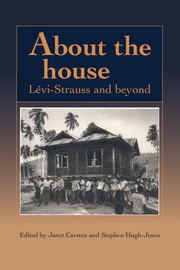Book contents
- Frontmatter
- Contents
- List of illustrations
- List of contributors
- 1 Introduction
- 2 Houses and hierarchies in island Southeast Asia
- 3 The resurrection of the house amongst the Zafimaniry of Madagascar
- 4 The hearth-group, the conjugal couple and the symbolism of the rice meal among the Kelabit of Sarawak
- 5 Houses in Langkawi: stable structures or mobile homes?
- 6 Having your house and eating it: houses and siblings in Ara, South Sulawesi
- 7 The Lio House: building, category, idea, value
- 8 Houses and hierarchy: the view from a South Moluccan society
- 9 Houses, places and people: community and continuity in Guiana
- 10 The houses of the Mẽbengokre (Kayapó) of Central Brazil – a new door to their social organization
- 11 Inside-out and back-to-front: the androgynous house in Northwest Amazonia
- Notes
- Bibliography
- Index
2 - Houses and hierarchies in island Southeast Asia
Published online by Cambridge University Press: 05 June 2012
- Frontmatter
- Contents
- List of illustrations
- List of contributors
- 1 Introduction
- 2 Houses and hierarchies in island Southeast Asia
- 3 The resurrection of the house amongst the Zafimaniry of Madagascar
- 4 The hearth-group, the conjugal couple and the symbolism of the rice meal among the Kelabit of Sarawak
- 5 Houses in Langkawi: stable structures or mobile homes?
- 6 Having your house and eating it: houses and siblings in Ara, South Sulawesi
- 7 The Lio House: building, category, idea, value
- 8 Houses and hierarchy: the view from a South Moluccan society
- 9 Houses, places and people: community and continuity in Guiana
- 10 The houses of the Mẽbengokre (Kayapó) of Central Brazil – a new door to their social organization
- 11 Inside-out and back-to-front: the androgynous house in Northwest Amazonia
- Notes
- Bibliography
- Index
Summary
For Southeast Asiansts, Lévi-Strauss's concept of the ‘house society’ has been one of the most stimulating and provocative to emerge in recent years (Lévi-Strauss 1983a: 163–76, 1987). Yet, considering the startling scope of his idea, Lévi-Strauss's treatment of it in print is so brief as to leave many questions unanswered. In The Way of the Masks, he compares the Kwakiutl numayma to the noble houses of feudal Europe, while merely hinting that the category of ‘house societies’ might be extended to include Ancient Greece, feudal Japan, the Philippines, Indonesia, Melanesia and Polynesia. The more recent records of his lectures (1987) are scarcely more illuminating, being highly compressed summaries of lines of thought originally developed throughout whole lecture courses. Thus, as others observe (Macdonald (ed.) 1987), his various essays at defining the concept remain sufficiently vague as to leave room for continued debate about the application of his model in particular cases. Island Southeast Asia provides a fertile field in which to explore the many dimensions of this intriguing yet elusive concept. Not only do its impressive vernacular architectures already provide an obvious clue to the importance of houses in this region, but it abounds in examples of kinship systems whose ambiguities have puzzled anthropologists, but which might be resolved by seeing them as house-focused systems.
In my research on the Sa'dan Toraja of highland South Sulawesi, I found it impossible to grasp the workings of their cognatic kinship system without an understanding of houses as the focal points of the system (Waterson 1984, 1986).
- Type
- Chapter
- Information
- About the HouseLévi-Strauss and Beyond, pp. 47 - 68Publisher: Cambridge University PressPrint publication year: 1995
- 48
- Cited by



